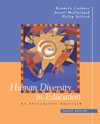 |  Human Diversity in Education: An Integrative Approach, 4/e Kenneth H. Cushner,
Kent State University, Kent
Averil McClelland,
Kent State University, Kent
Philip Safford,
Case Western Reserve University
Developing a Collaborative Classroom: Gender and Sexual Orientation
Chapter OverviewIn this chapter, the importance of gender role socialization to a person's identity is explained through discussion of the ways in which children learn to "become" members of a gender group. The part played by the school and by the teachers, administrators, and other adults as socialization agents is also discussed, as is the particular type of socialization—generally middle class—exercised by the school and the relation of that socialization to mainstream American values. It is proposed that traditional gender role stereotypes are both harmful and changing. Indeed, it is the very change in the nature of gender roles, as exemplified by Title IX, that is likely to cause some difficulties for students and teachers. In the same way, it is proposed that collaborative classrooms are particularly good vehicles for engendering understanding among both male and female students. Finally, the issue of sexuality is addressed, in part as a studentwide phenomenon—at least in middle and high schools—and in part in terms of an increasing need to attend to issues raised by students who are gay and lesbian and to issues created by the relations between homosexual and heterosexual students. |
|



 2003 McGraw-Hill Higher Education
2003 McGraw-Hill Higher Education